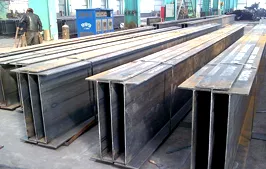



Difference Between Steel I-Beam and H-Beam
H-beams and I-beams are beams made of structural steel extensively used in construction applications. They are commonly used in building homes, bridges, large trailers, etc., due to the high strength imparted by them and the ease of construction.
H-beams and I-beams primarily differ in their cross-sections. Both have a common horizontal part called the “flange,” and a vertical part called the “web.” The web resists the shear stresses, and the flanges are made to withstand most of the bending moment coming over the steel beam.
This article discusses the significant differences between steel H-beams and I-beams used in the construction industry.
| I-Beams | H-Beams |
| I-Beams are steel beams fabricated by milling or rolling steel in an I-shape. It is made of a single piece of metal or aluminum throughout the unit. | H-Beams are steel beams made of rolled steel in the shape of the alphabet “H.” They are fabricated as built-up units. The flanges are welded to the web to form the H-section. H-beams are also called wide flange beams. |
| The web of I-beams is thinner than H-beams. | H-beams have greater web thickness compared to I-beams. This increased thickness gives strength to H-beams. |
| The flanges of I-beams are tapered with an inclination of 1:10 for better load-bearing capacity. Their thickness is less than that of H-beam flanges. | The flanges of H-beams have equal thickness and are parallel to each other. They are longer, wider, and heavier than I-beams. |
| The cross-section of I-beams is typically deeper in height than its width, which gives them resistance against local buckling. | The cross-section of H-beams is more optimized than I-beams, giving it a reasonable strength-to-weight ratio, i.e., more strength per unit area. They possess a greater surface area on the cross-section, hence high strength. |
| The moment of inertia of I-beams is less than H-beams, making them less efficient in resisting bending. | The wider flanges of H-beams gain a greater moment of inertia and high lateral stiffness. Hence, they have better bending resistance than I-beams. |
| I-beams are used for spans from 33 to 100 feet. | H-beams are used for spans of up to 330 feet that can be built up to any size and height. |
| I-beams are lightweight compared to H-beams. | H-beams are heavier than I-beams. |
| I-beams withstand direct and tensile loads. But they cannot withstand twisting loads due to their smaller cross-sections. | H-beam section can withstand direct loads and tensile loads. Its broad cross-section allows it to withstand twisting loads. |
| I-beams are suitable for making support frames and columns for elevators, trailers, trolley ways, hoists, structural steel buildings, and bridges. | H-beams are used as load-bearing columns for commercial buildings, for platforms, bridges, etc. Wide flange beams are commonly used for residential projects. |
H-beams, compared to I-beams, provide better mechanical properties and are hence considered an economical option for construction. Generally, I-beams are used as beams, and H-beams are used as load-bearing columns.
What is an H-beam?
H-Beams are steel beams made of rolled steel in the shape of the alphabet “H.” They are fabricated as built-up units. The flanges are welded to the web to form the H-section. H-beams are also called wide flange beams.
What are the applications of I-beams?
I-beams are suitable for making support frames and columns for elevators, trailers, trolley ways, hoists, structural steel buildings, and bridges.
Which is stronger, H-beams or I-beams?
The cross-section of H-beams is more optimized than I-beams, giving it a reasonable strength to weight ratio, i.e., more strength per unit area. They possess a greater surface area on the cross-section, hence high strength.